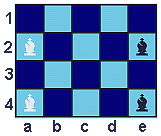You have a 4×5 chess board as follows:

You can move the four bishops in any order (not necessarily alternating black and white), provided that no move puts a piece in danger of being captured by a bishop of the opposite color.
What is the fewest number of moves needed for the black and white bishops to exchange places?
First black and white are symetrical so i will use white to move first. The correct sequence is as follows (with annotation):
MOVE
1.a2-b3
a4-b3 is the only other legal move and leaves only b3-a4 as a legal move so it is a dead end
2.e4-b1
the only other legal move, a3-a2, puts us in the same position as before so it can be disregarded as will all such moves.
3.e2-d3
again the only legal move
4. b3-d1
ditto
5. b1-a2
white has no legal moves so black must choose between b1-a2 d3-e4 and d3-c4 either of the latter move's limits the movement of that bishop and the third move places a black bishop in the "a" file wihout limiting the moves of the other bishop.
6.d3-c4
white still without moves.
d3-e4 if futile because the a4 bishop would not be able to get off the long diagnol a4-d1 until the b1 e4 diagnol is free. so we free it now by d3-c4
7. a4-c2
we need to clear the a4-d1 diagnol for the black bishop on c4 so one of the white bishops must go to e4. we may as well move the a4 bishop as the d1 bishop is in position to take e2 when it is free.
8. c2-e4
only legal move
at this point black still can not move so white must move but his only legal move without backtracking is d1-a4 and then back to d1 which means we have reached a deadlock and there is no solution.
|
|
Posted by Ariel
on 2004-02-28 23:21:15 |



